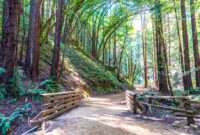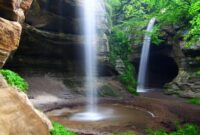Trails for Hiking Near Me: Discovering nearby trails opens up a world of adventure, from leisurely strolls to challenging climbs. This exploration delves into finding the perfect path, considering various hiker types, data sources, and presentation methods to ensure an enriching outdoor experience. We’ll cover everything from identifying reliable trail information to understanding crucial safety aspects and accessibility considerations.
This guide aims to equip you with the tools and knowledge necessary to plan your next hiking excursion effectively. We will explore different methods of gathering trail data, presenting that data in a user-friendly format, and incorporating user reviews and safety information to help you make informed decisions about your hiking adventures.
Understanding User Search Intent
The phrase “trails for hiking near me” reveals a user’s immediate need for local hiking information. However, the specific intent behind this search query is multifaceted and depends heavily on the individual user’s experience, fitness level, and desired hiking experience. Understanding this nuanced intent is crucial for providing relevant and useful search results.
The seemingly simple query masks a diverse range of user profiles and expectations. Different types of hikers will use this search phrase, each with unique needs and preferences that influence their search results’ effectiveness.
Different Hiker Profiles and Their Needs
The search “trails for hiking near me” attracts a broad spectrum of hikers. These can be broadly categorized by experience level, desired difficulty, and preferred trail features. Consider, for instance, a seasoned hiker seeking a challenging mountain climb versus a family with young children looking for a leisurely nature walk. Their requirements for trail information will differ significantly.
Experienced hikers might prioritize trail length, elevation gain, technical difficulty, and solitude. They may actively search for reviews mentioning specific trail features like rock scrambles, water crossings, or stunning vistas. Conversely, families with young children will likely prioritize shorter, less strenuous trails with easily accessible restrooms, shaded areas, and minimal elevation changes. They might look for reviews highlighting trail accessibility and the presence of picnic areas. Casual hikers might focus on trail proximity, scenic views, and the overall ease of the trail. They might use filters or search terms to specify distance, elevation, and trail type.
The Role of Location in Search Results
Location is paramount when interpreting “trails for hiking near me.” The search engine must accurately determine the user’s location, whether through IP address, GPS data, or explicit location input. The results must then prioritize trails within a reasonable proximity to that location, adjusting the radius based on factors like traffic and user preferences. A search from a densely populated urban area will yield vastly different results than a search from a rural location. For example, a search in New York City might return results for trails within city parks, while a search in the Rocky Mountains might display more challenging backcountry trails. The algorithm should also account for factors such as trailhead accessibility, parking availability, and proximity to public transportation, influencing the ranking and presentation of trails.
Trail Filtering and Sorting Mechanisms
Finding the perfect hiking trail can be overwhelming with numerous options. Effective filtering and sorting mechanisms are crucial for a positive user experience, allowing users to quickly narrow down choices based on their preferences and fitness levels. This section details the implementation of such mechanisms to enhance trail discovery.
Trail Filtering Methods
Users should be able to refine their search using various criteria. A robust filtering system allows users to select trails based on specific parameters. This significantly improves the efficiency of the search process.
- Distance: Allow users to specify a minimum and maximum distance range for trails. For example, a slider control could provide intuitive range selection. Predefined distance ranges (e.g., “Short,” “Medium,” “Long”) can also enhance usability.
- Difficulty: Categorize trails by difficulty levels (e.g., Easy, Moderate, Hard, Expert). These categories could be further defined with descriptive text explaining what each level entails (e.g., elevation gain, terrain type). Visual representations, such as color-coded icons, can improve clarity.
- Trail Type: Offer options such as “Loop,” “Out-and-back,” “Point-to-point.” Clear visual representations, like simple diagrams showing each trail type, would benefit users unfamiliar with these terms.
- Elevation Gain: Allow filtering by minimum and maximum elevation gain. Similar to distance, a slider control or predefined ranges would be beneficial.
- Features: Include checkboxes for various features, such as “Waterfalls,” “Lakes,” “River crossings,” “Panoramic views,” allowing users to select trails with specific desired features.
Trail Sorting Algorithms
Once filtered, trails need to be presented in a meaningful order. Several sorting algorithms can be used to prioritize trails based on user preferences.
- Relevance Ranking: A sophisticated approach would involve a relevance ranking algorithm considering multiple factors, weighting them according to user preferences. For example, a user who prioritizes short, easy trails near their location would see those trails ranked higher than longer, more difficult trails further away.
- Distance from User: Sorting trails by proximity to the user’s location is crucial for convenience. This requires integration with a geolocation service.
- Difficulty Level: Sorting by difficulty, from easiest to hardest or vice-versa, allows users to easily find trails matching their fitness level.
- Rating: If user ratings are available, sorting by average rating (highest to lowest) can guide users towards popular and well-regarded trails.
- Elevation Gain: Sorting by elevation gain (ascending or descending) can be helpful for users focusing on a specific type of challenge.
User Interface Design for Filtering and Sorting
The user interface (UI) should be intuitive and easy to navigate.
A well-designed UI should clearly display all filtering options, allowing users to easily select and deselect criteria. A clear visual representation of the selected filters is essential. The sorting options should be equally accessible, perhaps through a dropdown menu or a set of radio buttons. The UI should dynamically update the displayed trail list as users adjust filters and sorting preferences, providing immediate feedback and enhancing the user experience. Consider using interactive elements like sliders and checkboxes for an engaging experience.
Visual Representation of Trails
Effective visual representation of trails is crucial for users to understand trail difficulty, scenery, and overall experience before embarking on a hike. This involves conveying both the aesthetic appeal and the physical challenges of the trail through textual descriptions.
Scenic Overlook Description
Imagine reaching a rocky outcrop after a moderate climb. The panoramic vista unfolds before you: a valley carpeted in emerald green, punctuated by the silver ribbon of a river snaking its way through. Distant mountains rise majestically, their peaks shrouded in a hazy blue. The air is crisp and clean, carrying the scent of pine and damp earth. Wildflowers in vibrant hues – bright yellow buttercups and deep purple lupines – dot the meadow below. To the west, a dense forest of towering evergreens creates a dramatic contrast to the open expanse of the valley. The sun warms your face as you take in the breathtaking beauty of this natural amphitheater.
Challenging Trail Section Description
This section of the trail presents a significant challenge. The path becomes steep and rocky, requiring careful footing and possibly the use of hands for support. Loose scree underfoot makes each step precarious, and exposed roots and boulders necessitate a slow and deliberate pace. The vegetation here is dense, with low-hanging branches and thorny bushes encroaching on the narrow trail. The lack of shade exposes hikers to direct sunlight, making hydration crucial. A steep drop-off on one side of the trail adds to the difficulty, requiring hikers to maintain focus and awareness of their surroundings. This section demands both physical stamina and mental resilience.
Trail Junction and Branching Path Representation
A clear and concise system for representing trail junctions is essential for navigational clarity. We can use a textual system employing directional indicators and descriptive labels. For example:
“At the intersection, you will encounter three paths. The path to the left, marked by a small cairn, leads to the summit (2 miles, strenuous). The path straight ahead continues along the ridge (1 mile, moderate). The path to the right descends gently into the valley (0.5 miles, easy). Each path is clearly marked with blazes: red for summit trail, blue for ridge trail, and green for valley trail.”
This system allows for a consistent and easily understandable representation of trail junctions and branching paths, enhancing the user experience and improving navigational accuracy.
Conclusion
Ultimately, finding the ideal trail for hiking near you hinges on a blend of readily accessible information, user-friendly presentation, and an understanding of personal preferences. By utilizing the strategies and resources outlined here, you can confidently navigate the world of local trails and embark on memorable outdoor journeys. Remember to always prioritize safety and respect the natural environment.




